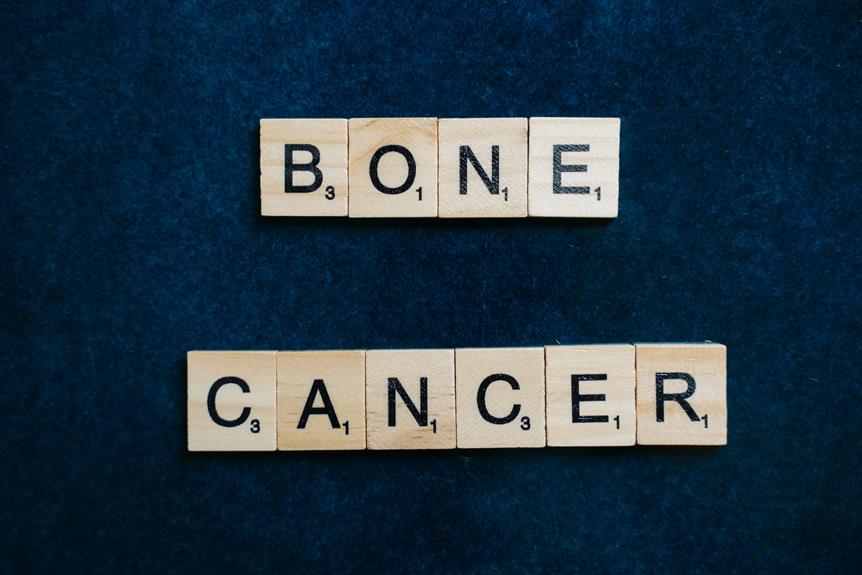Rare Bone Cancers Unveiled: Are You at Risk
This article provides an in-depth analysis of rare bone cancers, primarily osteosarcoma and Ewing sarcoma. It explores risk factors, symptoms, and cutting-edge treatments, supplemented by current statistics. The discussion extends to coping mechanisms, genetic implications, and the need for further research. With a data-driven approach, this piece serves as a valuable resource for patients, their families, and healthcare professionals, aiming to enhance understanding and management of these impactful yet often overlooked diseases.

Key Takeaways
- Bone cancer is a rare disease that includes types such as osteosarcoma and Ewing sarcoma.
- Osteosarcoma and Ewing sarcoma are the most common bone cancers in children and young adults.
- Treatment options for bone cancer include clinical trials, approved drugs, and specific treatments for different types of bone cancer.
- There is currently no evidence-based information on the prevention or screening of bone cancer.
Understanding Rare Bone Cancers
The journey to understanding rare bone cancers begins with an exploration of their types, including osteosarcoma and Ewing sarcoma, which are most prevalent among children and young adults. The rarity of bone cancers makes them a challenging field of study, but nonetheless of significant importance due to their potential severity. Identifying risk factors for bone cancers is a crucial step in early detection and prevention. Although rare, these cancers pose a significant risk, particularly to younger populations. Certain genetic conditions and exposure to radiation are known risk factors. However, many cases occur without any clear risk factors, making ongoing research critical. Understanding these cancers and their risk factors will equip individuals and health professionals with the knowledge to combat this formidable disease.
The Biology Behind Bone Cancers
Both the complexity and the diversity of biological processes involved in the development of bone cancers make this a challenging field of study. The biology behind bone cancer encompasses a variety of phenomena, from cell growth and differentiation to the pathways and mechanisms that go awry, leading to malignancy. The role of genetics in bone cancer is also significant, with certain genetic mutations and inherited syndromes associated with an increased risk. Recent research has shed light on the interplay between environmental factors, genetic predispositions, and the development of bone cancer. While our understanding of the biology behind bone cancer continues to evolve, it is clear that this is a multifaceted disease, influenced by a combination of genetic, environmental, and biological factors.
Identifying the Symptoms of Bone Cancer
Importantly, recognizing the symptoms of bone cancer early can significantly improve the prognosis and treatment outcomes. Symptoms may vary depending on the location and size of the cancer, but often include persistent pain, swelling, or tenderness in or near a bone. Diagnosing bone cancer can involve imaging tests, biopsies, and blood tests. It's crucial to consult a healthcare provider if these symptoms are experienced, as early detection can be critical in managing bone cancer symptoms effectively. Additionally, unexplained weight loss, fatigue, or sporadic fever might also be indicative of bone cancer. Remember, these signs can also be linked to other health conditions, so professional medical advice is essential for accurate diagnosis and treatment.
Risk Factors for Developing Bone Cancer
While anyone can develop bone cancer, certain risk factors can significantly increase the likelihood of this rare disease occurring. The exact causes of bone cancer are not completely understood, but certain genetic conditions, previous radiation treatment, and abnormal cell growth may play a role. It is important to note that having one or more risk factors does not guarantee the development of bone cancer. Prevention methods for bone cancer principally involve regular screenings for those at high risk, maintaining a healthy lifestyle, and monitoring for symptoms. Consultation with a health professional is critical for understanding personal risks and incorporating preventative measures. Continued research is vital in enhancing our understanding of bone cancer, its causes, and its prevention.
Diagnostic Procedures for Bone Cancer
The detection of bone cancer involves a variety of diagnostic procedures, and an accurate diagnosis is essential for determining the most effective treatment plan. With the advent of diagnostic advancements, physicians can now employ sophisticated imaging techniques such as CT scans, MRI, and PET scans to visualize the extent of the disease. Biopsy, the definitive diagnostic tool, involves the removal of a small tissue sample for microscopic examination. Moreover, blood tests are utilized to detect specific markers associated with bone cancer. Once a diagnosis is confirmed, doctors may suggest a blend of traditional and alternative therapies like radiation, chemotherapy, surgery, or targeted therapy. These strategies are tailored to the patient's specific type and stage of bone cancer, enhancing their chances of survival and recovery.
Various Types of Bone Cancer: A Closer Look
In this section, we will delve into a detailed examination of the various types of bone cancer, offering a closer look at their unique characteristics and manifestations. Primary bone cancers like osteosarcoma, Ewing's sarcoma, and chondrosarcoma are the main types, each presenting with distinct symptomatology. Timely diagnosis is crucial, emphasizing the importance of early detection. Osteosarcoma typically affects teenagers during growth spurts, whereas Ewing's sarcoma often appears in adolescents' pelvis or femur. Chondrosarcoma, mainly seen in adults, develops in the cartilage cells. The prognosis and treatment plan are determined by the cancer type and its stage. Advances in medical science have introduced emerging therapies in bone cancer treatment, enhancing survival rates and improving patients' quality of life.
Treatment Options for Rare Bone Cancers
Navigating through the complex landscape of treatment options for rare bone cancers necessitates an in-depth understanding of the disease and its unique characteristics. Over the years, diagnostic advancements have greatly improved the management of these cancers, allowing for personalized treatment plans. These may include surgery, radiation therapy, or chemotherapy, often used in combination. The choice of treatment depends on the type, stage, and location of the cancer, as well as the patient's overall health. Furthermore, emerging treatments, such as targeted therapy and immunotherapy, provide new hope. These innovative methods aim to treat cancer cells more precisely, while minimizing damage to healthy cells. Participation in clinical trials may also offer access to treatments not yet available to the general public.
The Impact of Bone Cancer on Patients
Bone cancer, despite its rarity, imposes significant physical and emotional burdens on patients, profoundly affecting their quality of life. The disease can cause severe pain, limit mobility, and necessitate invasive treatments, all of which have a substantial impact on quality of life. Additionally, the diagnosis itself can trigger a range of psychological effects, including anxiety, depression, and fear of the future. These emotional struggles can exacerbate physical symptoms, creating a vicious cycle that further deteriorates patients' well-being. It's crucial that healthcare providers not only focus on treating the cancer but also address these psychological issues, implementing strategies to help patients cope effectively. Ultimately, the multifaceted impact of bone cancer underscores the importance of holistic care in managing this disease.
Coping Strategies for Bone Cancer Patients
While the diagnosis and treatment of bone cancer can be mentally and physically draining, there are several coping strategies that patients can employ to help manage their symptoms and improve their overall quality of life. One key aspect involves managing pain, which can be accomplished through medication, physical therapy, and alternative methods such as meditation or yoga. Another vital coping strategy is the establishment and utilization of support networks. These networks can include both professional healthcare providers and personal connections like family and friends. Support networks can provide emotional assistance, practical help, and a sense of community, which are all crucial in coping with a bone cancer diagnosis.
The Role of Genetics in Bone Cancer
In the complex landscape of bone cancer, genetics plays a pivotal role, and understanding this connection can shed light on both the origins of the disease and potential avenues for treatment. A genetic predisposition can significantly increase an individual's risk of developing bone cancer. Certain inherited syndromes, carried through generations, may predispose individuals to this rare disease. Genetic testing for bone cancer is thus an emerging field, offering potential for early detection and targeted treatment. It can identify individuals carrying specific genetic mutations, allowing for preventive measures and personalized care. In conclusion, genetics has a profound impact on bone cancer, and its study will continue to be fundamental in combating this disease.
Advances in Bone Cancer Research
Our understanding of bone cancer has significantly improved over the years, thanks to the remarkable advances in research. These strides have resulted in significant advances in treatment, providing hope for patients diagnosed with this rare disease. Innovations range from more effective chemotherapy regimens to advances in surgical techniques that help preserve limb function. The advent of targeted therapies, which attack specific mutations within cancer cells, has also revolutionized treatment. In addition, researchers are exploring emerging therapies, such as immunotherapy, which harnesses the body's immune system to fight cancer. While progress has been substantial, ongoing research is crucial to further refine these treatments, reduce side effects, and improve survival rates for bone cancer patients.
Resources for Bone Cancer Patients and Their Families
Navigating through a bone cancer diagnosis can be challenging, but numerous resources are available to help patients and their families cope with the journey. Support networks are crucial for emotional and practical assistance. Organizations such as the American Cancer Society offer comprehensive support services, including counseling, nutritional advice, and transportation assistance. Clinical trials provide a ray of hope by offering access to innovative therapies before they are widely available. The National Cancer Institute's website is an invaluable resource for finding ongoing clinical trials. Additionally, various online platforms offer forums to share experiences and advice, contributing to a sense of community and mutual support. Hence, a combination of professional medical services, support networks, and clinical trials can significantly ease the journey for bone cancer patients and their families.
Frequently Asked Questions
What Lifestyle Changes Can Help in Managing Bone Cancer?
Managing bone cancer may require several lifestyle changes including dietary adjustments and pain management. A balanced diet rich in fruits, vegetables, lean proteins, and whole grains can support overall health and aid in treatment recovery. Pain management strategies, ranging from medication to physical therapy, can help control discomfort. Engaging in moderate exercise, with a healthcare provider's approval, may also boost energy levels and improve well-being. Regular check-ups are crucial to monitor progress and adjust treatment plans as needed.
Is Bone Cancer Hereditary and What Other Diseases Are Associated With It?
Bone cancer can indeed have a hereditary component, often linked to certain genetic mutations. These mutations may also be associated with other diseases, creating a heightened risk. However, it's important to note that most bone cancers are not strictly inherited and can occur due to a variety of factors. Bone cancer screening can help identify these genetic mutations early, potentially leading to more effective treatment and management strategies.
What Is the Survival Rate for Different Types of Bone Cancer?
Survival rates for bone cancer vary based on type and stage. Osteosarcoma has a five-year survival rate of about 60-80%, while Ewing sarcoma is around 70%. Advanced diagnostic techniques aid in early detection, increasing survival chances. Treatment options include surgery, radiation therapy, and chemotherapy. Participation in clinical trials may also be considered. It's important to discuss individual prognosis and treatment plan with a healthcare provider.
How Does Bone Cancer Affect a Patient’s Daily Life and Activities?
Bone cancer can significantly impact a patient's daily life and activities, primarily due to pain and mobility challenges. Pain management becomes a crucial part of their routine, often requiring medication and physical therapy. Mobility issues may arise due to the location of the cancer, potentially limiting daily tasks and independence. Patients may need to use assistive devices or modify their activities to accommodate these challenges, which can also have emotional and psychological impacts.
What Psychological Support and Mental Health Resources Are Available for Bone Cancer Patients?
Bone cancer patients have access to several mental health resources to help build emotional resilience during their treatment journey. These include individual counseling, family therapy, and support groups comprising patients undergoing similar experiences. Support groups, in particular, provide a safe space to share experiences and coping strategies. Additionally, online platforms and telehealth services have made psychological support more accessible, ensuring patients can receive help comfortably and conveniently.
Conclusion
This article provides a detailed overview of rare bone cancers, particularly osteosarcoma and Ewing sarcoma, highlighting their symptoms, risk factors, and treatment options. It underscores the significance of early detection and effective management, the importance of patient coping strategies, and the role of genetics. Despite some limitations in prevention and screening, advances in research show promise. More resources and support systems are needed for patients and families affected by these cancers, emphasizing the necessity of continued research and awareness.

This post has been generated by AI and was not reviewed by editors. This is Not legal advice. Please consult with an attorney.




